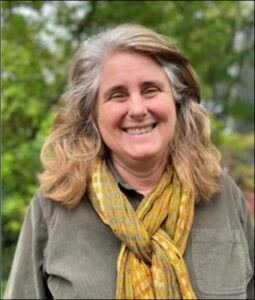By DNR staff

Andrea Diss-Torrance, the Wisconsin Department of Natural Resources Invasive Forest Insects Program coordinator, retired last month after a 30-year career with the DNR. / Photo Credit: Wisconsin DNR
After an incredibly productive and meaningful 30-year career with the Wisconsin Department of Natural Resources, Andrea Diss-Torrance retired on Jan. 24.
“It’s been an honor to watch Andrea tackle forest health issues with her mixture of determination, humor and intelligence,” Forest Health team leader Becky Gray said of the coordinator of the team’s invasive forest insects program. “She will be greatly missed as she starts her next adventures.”
Diss-Torrance plans to spend time in retirement on sculpture, plant breeding and travel.
In an attempt to bring a personal touch and Andrea’s own insights to her shining list of career accomplishments, here are “Five Questions With Andrea Diss-Torrance.”
-
- What was your favorite achievement on the job?
“There are so many projects we had going on for long terms, some on a five-year arch and some on a 10-year arch. The scope of the issues I dealt with were endlessly interesting, so large and complex, with opportunities for cross-application with other programs, people and states to form a stronger final product.
“Maybe the highlight was the chance to develop an Integrated Pest Management program for spongy moth. The entire program! As someone who had studied spongy moth, you’d never expect to get the chance to put an entire program together from scratch — the aerial suppression program and grant, the outreach and education standpoint and the biological controls plan.
“I set up a plan to bring in Entomophaga maimaga (a fungus that is fatal to spongy moth caterpillars), and that had quite an impact. Also, a new way of collecting E. maimaga spores from (caterpillar) cadavers instead of from soil. I called all my friends in spongy-moth land to let me know if they saw a lot of E. maimaga damage so we could go and collect the caterpillars off the side of the tree within a few days.
“We went to West Virginia, Massachusetts, Michigan … We picked like crazy people. My mom still talks about the time she came along one trip to help us pick caterpillars.
“I also had a critical role in the change of the (insect’s) name from gypsy moth to spongy moth. The ESA (Entomological Society of America) wanted to change the name, and I told them we needed it in place by that January because we had some outbreaks happening. We got them to involve managers from state forest health programs, forestry businesses and groups.”
- What was your most impactful accomplishment?
“Building a plan to reduce the distance campers moved firewood and setting up a multiagency program on firewood with DATCP (the Wisconsin Department of Agriculture, Trade and Consumer Protection). We created the regulations, set up the education and outreach, and got the Wisconsin State Parks system involved to carry our message.
“Later, we connected with social scientists here and set up 10-year repeating surveys to see whether our work was making a difference. We were so happy to see that not only did it start changing how campers behaved at the park, but it also showed we succeeded in changing how they behaved at home in terms of the way they used firewood.
“It was the first program I was part of that had a national impact, and that was gratifying. … The results were very different from when we started.”
- What was the biggest change you saw during your time with DNR?
“We worked with Forest Health specialists and state foresters across the country in persuading the US Forest Service to increase core funding for all state forest health programs for the first time since 1989.”
- What was the funniest single work moment you remember?
“My supervisor told me I had to learn how to use a chainsaw because we used to take trees down to study them — to count the caterpillars. The supervisor said: ‘you need to know what’s a safe tree to take down and what isn’t.’
“In class, the Menominee (tribe) had the hairiest stories about terrible things that happened from misuse of a chainsaw. Really rough stories. So, I was taking it seriously.
“Then, the instructor said when someone is cutting down a tree, I should stand next to their truck — because they’d never let a tree fall on their truck!”
- Finally, what have been your proudest moments as you wind down your career?
“These last few weeks have been fantastic. I recommend ramping down before you retire!
“I heard so many beautiful things from so many people, and I had a chance to respond and thank them. It was really gratifying to touch base with everyone again.”
